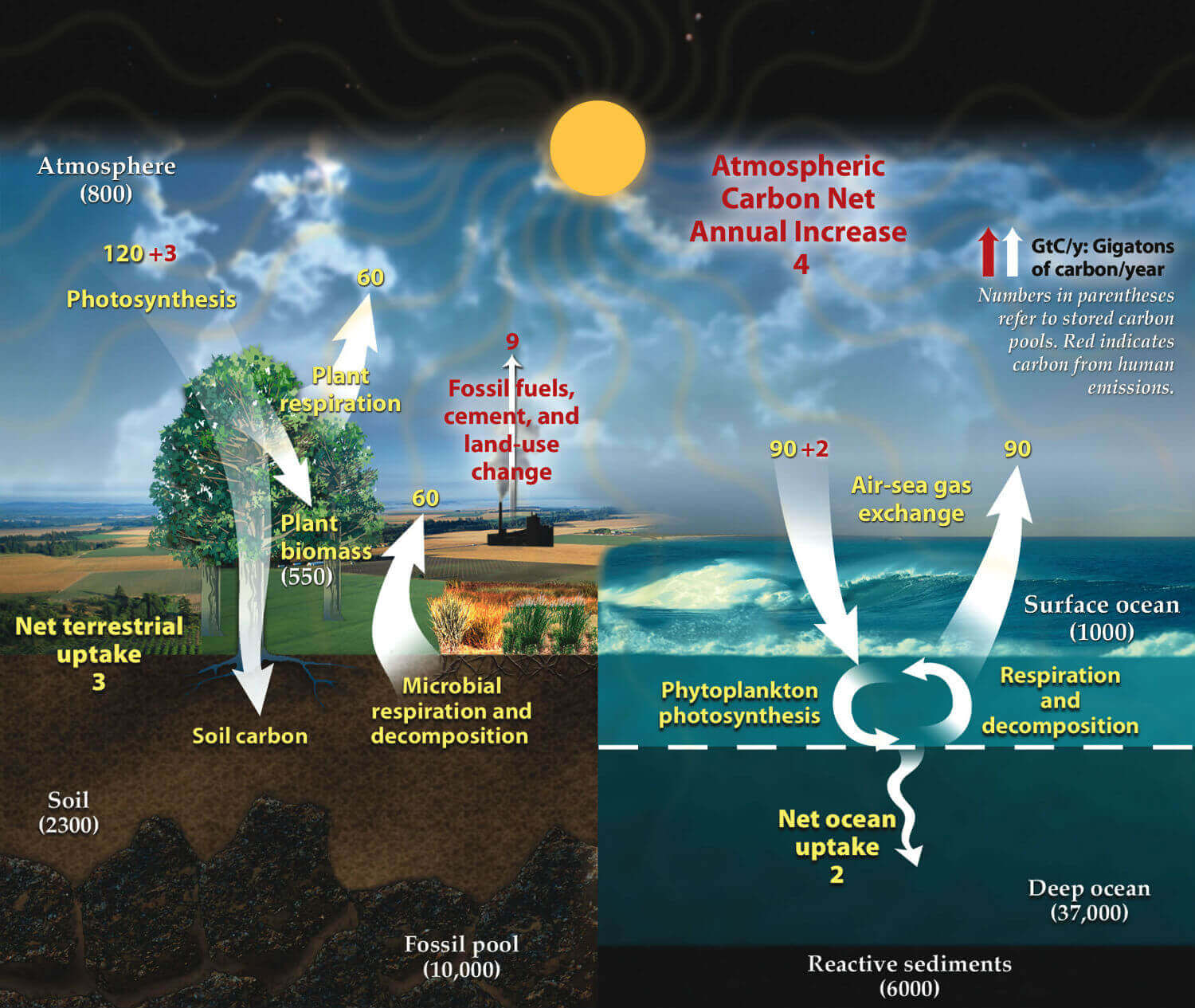What It Would Take to Suck CO2 Back Out of the Atmosphere

Share
If greenhouse gases are such a problem, can’t we just suck the carbon dioxide back out of the atmosphere? It’s a perfectly reasonable question and an important area of technological research to pursue. The technique is referred to as negative emissions technology.
As emissions remain high, experts are starting to accept that we’ll need to deploy some form of carbon capture technology to keep the world below two degrees Celsius of warming (the aim of the Paris agreement and generally considered to be the level above which dangerous tipping points can occur).
There are, broadly, two methods of negative emissions tech. One involves enhancing natural processes, and the other involves high-tech solutions. It’s crucial to understand that the Earth’s carbon cycle is complex.

Image Credit: US Department of Energy
Sometimes, tweet-level climate change skeptics will quote individual parts of this graph to muddy the waters: “The oceans absorb ten times as much carbon as we emit!” Yes, but it’s absorbed by plankton and other creatures and released when they die. The net absorption is much less than what we emit; and, of course, this does little to explain why atmospheric carbon dioxide concentration has increased from 280ppm to well over 400ppm in the industrial era. We have disrupted the complex balance.
We could tweak this cycle. An example is "fertilizing" the ocean with iron oxide to encourage the growth of plankton that will absorb more carbon dioxide. By some estimates, this could offset up to ten percent of current emissions, and it might cost $50 per ton of carbon to do this at the low end of cost estimates. This requires a massive-scale project, with virtually every suitable site fully fertilized with technology that has not yet been tested and developed. So your annual budget is $50 billion, providing you’re happy to dump iron into the ocean without worrying too much about the consequences.
Unfortunately, this risky strategy really is about as cheap as it gets. You can account for perhaps another ten percent by "liming" the oceans—this encourages calcification, or the formation of calcium carbonate (limestone) as a store of carbon, at a minimum price of $70 per ton.
Leaving the oceans alone for a moment, another favored tactic is BECCS: that is, bio-energy with carbon capture and storage. The latest IPCC report has several scenarios whereby the only way to stabilize the climate is to rely on the widespread deployment of BECCS.
The idea here is that a large portion of our energy is made from biofuels and bioenergy. These processes are generally touted as being carbon-neutral because the CO2 that is generated when the biofuels are burned was captured by the plants during their lifetimes, as they grew. If you combine this with the carbon capture and storage technology that may allow us to store carbon from fuel-combustion power plants underground or at the bottom of the ocean, you have a net sink of carbon.
But deploying this on a wide scale means you need a big chunk of your energy and electricity to be produced by biofuels in power plants. This cannot happen if current trends continue; the US currently supplies around ten percent of its gasoline and two percent of its electricity from bioethanol and biomass, respectively. This requires 40 percent of US corn production, raising questions about how sustainable it is to grow fuels where we must also grow food. Alongside this, deploying the technology still costs $70 to $250 per ton, or almost $2.7 to $9.6 trillion a year to offset our current carbon emissions; comparable to what the world currently spends on energy.
For that cost and scale of project, you might as well build solar power plants and electrify everything. Eventually, the project might even pay for itself. Burying CO2 does not pay for itself; it doesn’t give you energy, it’s just a sink of money.
Be Part of the Future
Sign up to receive top stories about groundbreaking technologies and visionary thinkers from SingularityHub.


There are other, similar ideas, most of which involve burying plant life in suitable locations so that it can’t decay and release the CO2 it absorbed while alive, instead becoming a more long-term sink. Large-scale afforestation is another idea. But this suffers from the same cost problems, the same land use problems, and is very difficult to scale. We’d need to plant forests the size of Europe, and use a fifth of global freshwater supply to grow them. Few have actually demonstrated that they are feasible, and at the prices they quote.
I’ve talked about the "natural" solutions—artificially enhancing nature’s sinks of carbon in the oceans and in plants—first. They are often the most economically and technologically feasible. But I imagine when most people envision a magical technology that can suck carbon out of the atmosphere, they’re probably picturing some kind of giant vacuum cleaner or a high-tech solution for direct air capture (DAC) technology.
Initially, it’s attractive: high-tech, no need for massive land or water use, no messing around with nature. The problem is that none of these solutions is scalable yet. There are plants that can do this already, like Climeworks in Switzerland. But it currently only captures 900 tons annually, offsetting the emissions of around 200 cars. The actual cost may be $1,000/ton at the moment; Climeworks will optimistically tell you it can be reduced to $100/ton or less.
The cost for DAC may well prove prohibitive. We also need to consider the energy requirements. The fundamental laws of physics dictate that capturing a ton of carbon once it’s been emitted into the atmosphere requires a theoretical minimum of 1.8 gigajoules of energy. Further, that chemical minimum requirement is usually only a small fraction of the total cost including transport and sequestration.
Real-life processes are rarely that efficient, and so once everything is taken into account (including the storage), we’re possibly looking at 12 gigajoules of energy. If you think technology is boundless in its wonders and can always improve efficiencies, consider that the laws of thermodynamics are a cruel mistress. Even today, after over a century of use, fossil fuel power plants are only around 40 percent efficient—the rest of the energy is wasted as heat.
What does this mean for our plan to neutralize global carbon emissions? These are all back-of-the-envelope calculations, but they give us an idea of scale. At this point, the energy required to suck CO2 out of the air is comparable to current world energy consumption; in other words, unless you can generate that energy renewably, it’s counterproductive. Many of the existing prototype direct air capture projects—such as Climeworks—may emit more carbon than they sequester away when you take their energy use into account.
Technology will play a huge role in the fight against climate change. Crucially, as early as possible, we need to switch to low-carbon solutions. Capturing and storing CO2 in the chimneys of fossil fuel power plants is far more viable than scrubbing it from the atmosphere once it is emitted and diffused. Better still, don’t emit it at all, through energy that’s both renewably sourced and more efficiently used. The earlier this is done, the better; even this brief discussion illustrates the difficulty of offsetting just one year of emissions. We must invest in negative emissions technology, but it is no silver bullet.
Image Credit: Pakhnyushchy / Shutterstock.com
Thomas Hornigold is a physics student at the University of Oxford. When he's not geeking out about the Universe, he hosts a podcast, Physical Attraction, which explains physics - one chat-up line at a time.
Related Articles

How Will the Universe End? The Dark Eternity That Awaits Us Trillions of Years From Now

Data Centers in Space: Will 2027 Really Be the Year AI Goes to Orbit?

How Scientists Are Growing Computers From Human Brain Cells—and Why They Want to Keep Doing It
What we’re reading